Zoom
Trash
Related: English Tenses
- Word Formation Types
- Webbsidor Bra saker
- Poetry
- Education
- Enterprise

Viewcontent. Mentor Text Lessons...inspired by Picture Books. How did this page of quality lessons come about?
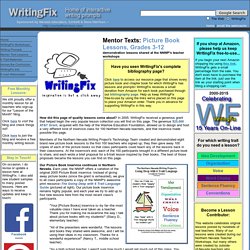
In 2005, WritingFix received a generous grant that helped begin the very popular lesson collection you will find on this page. The generous $25,000 AT&T Grant, acquired with the help of the Washoe Education Foundation, allowed us to design and host a very different kind of inservice class for 100 Northern Nevada teachers, and that inservice made possible this page.
Members of the Northern Nevada Writing Project's Technology Team created and demonstrated eight brand new picture book lessons to the first 100 teachers who signed up; they then gave away 100 copies of each of the picture books so that class participants could teach any of the lessons back in their classrooms. At the inservice's end, each of the 100 participants brought in a different picture book to share, and each wrote a brief proposal for a 6-trait lesson inspired by their books. The best of those proposals became the lessons you can find on this page. Austral Ed Children's Books - Sophisticated Picture Books. July 2012 This is very much an initial list of sophisticated picture books for older readers.
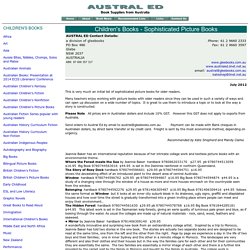
Many teachers enjoy working with picture books with older readers since they can be used in such a variety of ways and can open up discussion on a wide number of topics. It is great to use them to introduce a topic or to look at the way a story is constructed. Please Note All prices are in Australian dollars and include 10% GST. However this GST does not apply to exports from Australia. Send orders to Austral Ed by email to austral@gleebooks.com.au Payment can be made with Bank cheques in Australian dollars, by direct bank transfer or by credit card. Picture books in the ESL classroom - Fremmedspråksenteret - Høgskolen i Østfold. Introduction When Norwegian teachers of English in lower and upper secondary schools are asked what literature they use in their classrooms, my experience is that the vast majority point to short stories, novels, drama and some poetry.
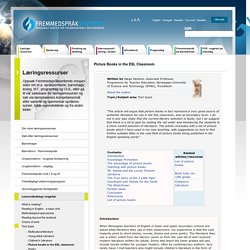
The literature they use is either culled from the literary canon or from the vast list of well received modern literature written for adults. Some who teach the lower grades will also include novels written for younger readers, often by contemporary authors. PictureBooksForOlderReaders.pdf. Reading Aloud in the High School Language Class: A Gateway to Cultural Awareness - Katrina L. Coovert - Google Böcker. 34-1%2003%20Alexander.pdf. Heise Reads & Recommends: Guest Post: Picture Books in a High School Classroom? Absolutely!
Interpretive responses to images in picture books by primary and secondary school students: Exploring curriculum expectations of a ‘visual grammatics’ - Unsworth - 2014 - English in Education. 10 Picture Books for Older Children (8-11) Picture books in the secondary classroom? ALAN v28n3 - Picture Books for Young Adult Readers. Picture Books Through Puberty. By Irma Colven The myriads of books that can be found tossing and tumbling in my mini van, range from professional to pictorial.
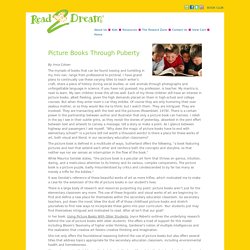
I have grand plans to continually use these varying titles to teach writer’s craft, share a piece of history during social studies, or visit animals through photographs and unforgettable language in science. If you have not guessed; my profession, is teacher. My mantra is, read to learn. My own children know this all too well. The picture book is defined in a multitude of ways, Sutherland offers the following, "a book featuring pictures and text that extend each other and reinforce both the concepts and storyline, so that neither eye nor ear senses an interruption in the flow of the book. " PictureThis.pdf. Using Picture Books to Explore Identity, Stereotyping, and Discrimination. ReadWriteThink couldn't publish all of this great content without literacy experts to write and review for us.
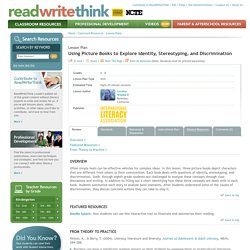
If you've got lessons plans, videos, activities, or other ideas you'd like to contribute, we'd love to hear from you. More Find the latest in professional publications, learn new techniques and strategies, and find out how you can connect with other literacy professionals. More Teacher Resources by Grade. Sophisticated picture books. Targeted at older children, Sophisticated picture books weave words and pictures to tell a story.
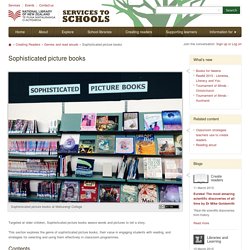
This section explores the genre of sophisticated picture books, their value in engaging students with reading, and strategies for selecting and using them effectively in classroom programmes. Contents. Using Picture Books as a Secondary Reading Intervention. Several years ago, when I was co-teaching Science, I found that the reading level of the text books was far above the reading level of many students in the classroom.
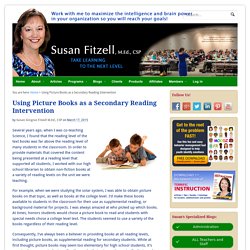
In order to provide materials that covered the content being presented at a reading level that supported all students, I worked with our high school librarian to obtain non-fiction books at a variety of reading levels on the unit we were teaching. For example, when we were studying the solar system, I was able to obtain picture books on that topic, as well as books at the college level. FLaRE%20Professional%20Paper%20-%20Using%20Crossover%20Picture%20Books.pdf. Picture Books in Secondary Libraries. February 27th, 20142 Comments A recent blog post by Shannon Miller got me thinking (again) about the value of picture books for all ages of students.

The Benefits of Using Picture Books with Secondary Level Students – Enroll.com. Have you ever thought of using picture books to teach middle or high school level literacy?

It might not have crossed your mind, but they are actually a great tool to use to teach many literacy concepts. Reading picture books to middle and high school students might seem inappropriate for their age, but you may be surprised of the outcome. What are the benefits? Expand Vocabulary: Prior to reading a picture book aloud, you can introduce a few key vocabulary words that will be found throughout the story that may be challenging for your audience. Explain what they mean and discuss them throughout the reading. Teach How to Use Context Clues: Picture books are a great way to teach how to use context clues to determine the meaning of words. Increase Reading Comprehension: Although the students are not doing the reading, they are listening and understanding the story elements. LanguageandLiteracyTheoryandPractice - Picture books in secondary. Picturebooks in the Secondary Classroom by Jenna Gardner on Prezi.
Using Picture Books with Older Learners.doc. Picture-Books-in-the-Secondary-Classroom.pdf. Picture Books in the Secondary Classroom: Personal Connections, Creative Engagements, Critical Responses. By Janelle Mathis, University of North Texas, Denton, TX Picture books have been defined over the past few decades with great integrity and attention to the complex interaction that occurs for the reader through the visual aspects of such books—text, illustrations, total design; a commercial product; a social, cultural, historical document (Bader, 1976).
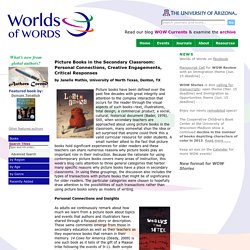
Still, when secondary teachers are approached about using picture books in the classroom, many somewhat shun the idea or act surprised that anyone could think this a valid curricular resource for older students. A small number attest to the fact that picture books hold significant experiences for older readers and these teachers can share numerous reasons why picture books play an important role in their instruction. Personal Connections and Insights As adults we continuously remark about how much we learn from a picture book about topics and events that authors and illustrators have shared through a focused story or description. Tell Me a Story: Using Children's Literature with Secondary Students - MackinVIA Connext. By Susan Nightingale, A Pass Educational Group April, Contractor of the Month When I taught ‘at-risk’ middle school math students, I often found myself looking for ways to engage a group of students that had basically already quit before the school year even began.
One such activity involved using children’s books, designed for elementary students, to introduce mathematical concepts to my learners. At the time, I didn’t realize that I was utilizing a learning method. I just knew that everyone loves a story, and a children’s story book looks much less intimidating than the usual explanations and examples in a Pre-Algebra textbook. Using Childrens Literature to Spark Learning. Grades 3 – 6 | Lesson Plan | Standard Lesson American Folklore: A Jigsaw Character Study Groups of students read and discuss American folklore stories, each group reading a different story. Using a jigsaw strategy, the groups compare character traits and main plot points of the stories. A diverse selection of American folk tales is used for this lesson, which is adaptable to any text set. Grades 9 – 12 | Lesson Plan | Unit. Literature integration across the curriculum.
Viewcontent. Lisabeth Richter. Lisabeth Richter Final Project November 16, 2004. Top 10 Picture Books for the Secondary Classroom by Kim McCollum-Clark. As a teacher of future English teachers, I am always trying to open my students’ eyes to the wonder and power of the picture book, both as an art form and as a terrific instructional tool for the secondary classroom. Being students of capital-L literature, my teacher-babies sometimes forget to consider these compact and powerful texts. It’s the best way I know to get numerous, diverse and COMPLETE texts into students’ minds. It’s hard enough to squeeze out the time in the overcrowded middle and high school English curriculum to read young adult and classic novels, but with picture books, you can read the entire work aloud, model the focus you want students to concentrate on, let them explore the craft, have the discussion, and even try it out in their own writing–all in one period!
So here, in no particular order: my top ten. 1. 2.